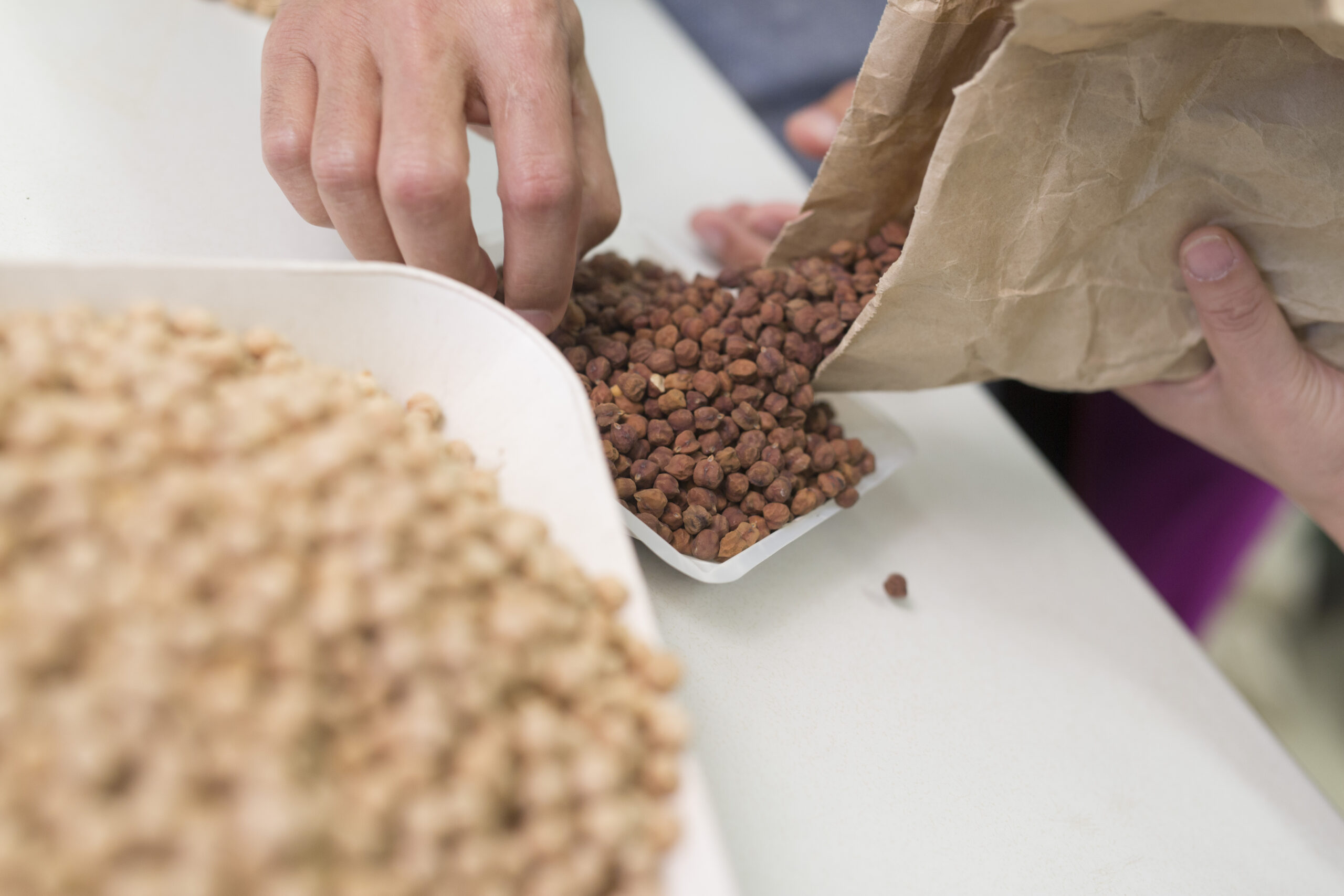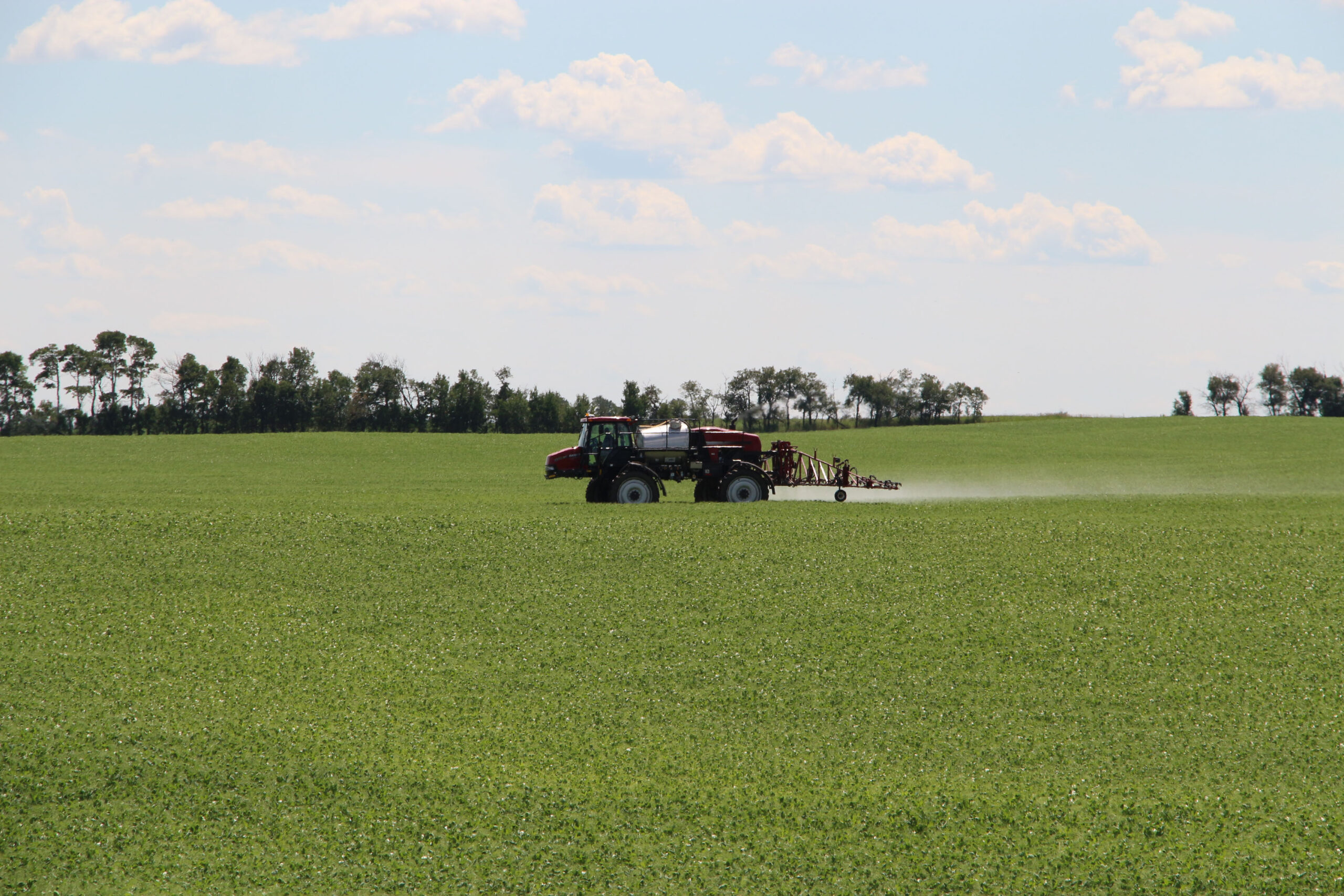Overview
Recent field surveys have confirmed the widespread presence of Group 11 (strobilurin, Qol) fungicide insensitive strains of the anthracnose pathogen (Colletotrichum lentis) in lentil fields across Saskatchewan.
Monitoring for Group 11 insensitivity in the anthracnose pathogen was initiated in response to a report of low field performance by a Group 11 fungicide product. Field samples were collected and sent away by BASF, as part of due diligence, to be screened for fungicide insensitivity. Testing detected a mutation (G143A) which enables the anthracnose pathogen to confer cross resistance to all Group 11 fungicides. BASF collected additional anthracnose samples in 2019 from several targeted fields with a history of heightened fungicide use, tight lentil rotations, and heavy disease pressure. Analysis of these additional samples also confirmed the presence of insensitive anthracnose across the Saskatchewan lentil growing region. An industry-led task force was established and remains dedicated to bringing expertise together to develop recommendations for fungicide insensitive anthracnose.
Fields assessed in 2019 did not represent a random survey because they were specifically selected for their increased risk of insensitive anthracnose populations. To fill this gap, comprehensive anthracnose surveys were initiated during the 2020 and 2021 growing seasons to gain a better understanding of the extent and severity of Group 11 insensitive anthracnose in Saskatchewan lentil.
The subsequent surveys (2020, 2021) are part of a larger research project, led by Dr. Michelle Hubbard and Dr. Bruce Gossen with Agriculture and Agri-Food Canada (AAFC) entitled: “Fungicide insensitivity in Colletotrichum lentis, the causal agent of anthracnose of lentil”. Initial findings indicate that strobilurin insensitive strain(s) of the anthracnose pathogen are now widespread in Saskatchewan and implementation of farm management practices that are effective against insensitive populations of anthracnose are necessary.
Anthracnose in Lentil
Caused by the fungus C. lentis, anthracnose is one of the most widespread and significant foliar diseases impacting lentil in Saskatchewan. This disease can be particularly destructive in the presence of warm (20–24°C), moist environmental conditions, including rain, humidity, or leaf wetness for an 18–24 hour duration and shortened crop rotations. Because C. lentis survives as microsclerotia on infected lentil residue for up to four years, it is recommended to avoid planting lentil in the same field for at least four years.
Microsclerotia on the soil surface are splashed onto lower parts of the plant, causing visible symptoms about 7–8 days after initial infection. Lesions with a water-soaked appearance are typically first observed on the lower leaves during the 10-node to early flowering stages. Sporulation occurs in lesions and can spread quickly throughout the canopy, infecting stems and neighboring plants via rain splash, wind, or plant-to-plant contact. The disease is considered polycyclic because it can infect multiple times throughout the growing season. Consequences of anthracnose infection in lentil include leaf drop, stem girdling, wilting, lodging, and plant death. Upon canopy closure, severe anthracnose is often recognized by rapidly expanding diseased patches that appear as yellow, grey, or dark brown patches in an otherwise healthy looking field.
Additional information on this lentil disease can be found in the Managing Anthracnose in Lentil factsheet.
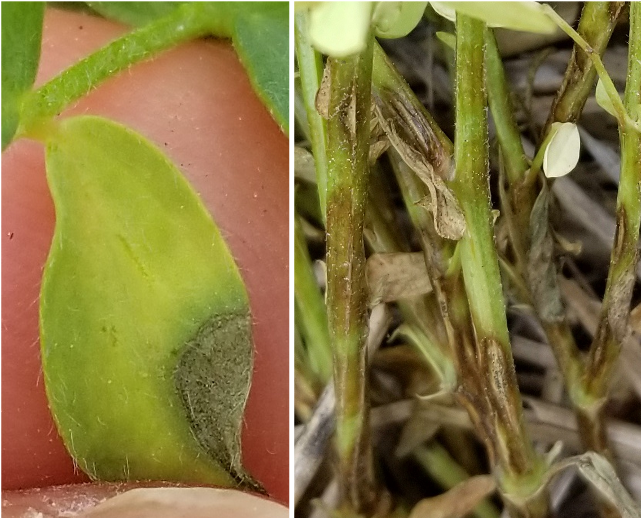
Source: Michelle Hubbard, AAFC
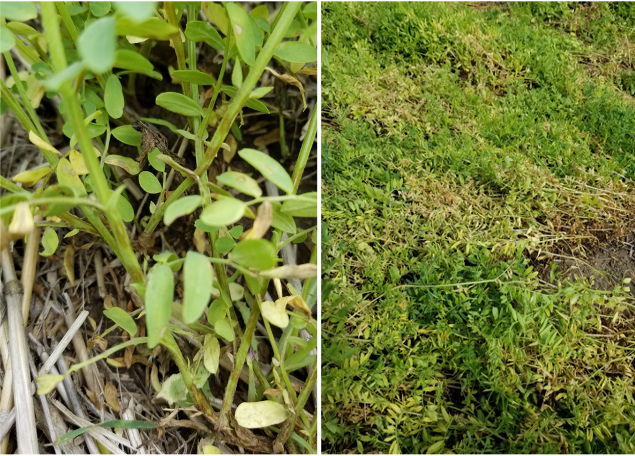
Source: Michelle Hubbard, AAFC
Fungicide Insensitivity
Fungicide insensitivity (resistance) is the acquired, heritable reduction in sensitivity to a specific fungicide. Fungicide insensitivity is the result of mutation, recombination, and multiplication of the pathogen and the selection of pathogen populations via fungicide application. The Fungicide Resistance Action Committee (FRAC) considers the risk of developing fungicide insensitivity to vary depending on pathogen risk, fungicide risk, and agronomic or environmental factors. Refer to the Saskatchewan Pulse Growers’ (SPG) Fungicide Insensitivity in Pulse Crops factsheet for more information.
C. lentis is considered a medium risk pathogen for fungicide insensitivity. Its risk is buffered by the fact that the pathogen does not, or very rarely, sexually reproduce under field conditions. However, the anthracnose pathogen has several other characteristics that contribute to a heightened risk of fungicide insensitivity including: polycyclic disease cycle with infection at multiple crop stages, high spore production, ability to spread by wind, and ability to overwinter.
Strobilurin (Group 11, Qol) fungicides are a high risk for developing insensitivity. Partially responsible for this categorization is the fact that strobilurin chemistries have a very specific target site (mode-of- action). In addition, a single gene mutation is sufficient for a pathogen to develop insensitivity. Moreover, this mutation enables cross resistance to all strobilurin fungicides which means that none of the Group 11 fungicide actives will provide effective control in fields with high populations of insensitive isolates. Anthracnose management has been reliant on fungicide application with a high number of registered products containing a Group 11 component.
Surveys of Commercial Lentil Fields
Lentil anthracnose surveys, led by Dr. Michelle Hubbard, were conducted in 140 and 36 commercial lentil fields during the 2020 and 2021 growing seasons, respectively. Disease data was obtained from 130 and 29 of these fields. Lentil plant samples collected during these surveys were sent to the pulse pathology laboratory at Swift Current Research and Development Centre (AAFC) for further analysis.
Protocols for these surveys specified that ten random sites per field, distributed in a W pattern, were assessed. The slope position of each site was recorded as a low point, mid-slope or flat, or a high point. Ten randomly-selected plants at each site were rated for anthracnose incidence and severity. Based on the percent of plant area impacted by disease, severity was assessed on 0–9 rating scale in 2020 and a 0–5 rating scale in 2021. See Table 1 for detailed descriptions. Fungicide application data were also collected from some of the fields during the 2020 survey.
Table 1. Description of rating scale used to assess anthracnose severity in 2020 survey (0-9) and 2021 survey (0-5)
| Rating | 2020 Rating Scale | 2020 Rating Scale | ||
|---|---|---|---|---|
| 0 | 0% | No lesions/symptoms. | 0% | No lesions/symptoms. |
| 1 | <2% | Plant area affected. | <5% | Plant area diseased (lower canopy). A few superficial lesions at stem base. |
| 2 | 2-5% | Plant area affected. | 5-25% | Stems and leaves affected in the 10 plants being rated (lower canopy). Lesions, some leaf drop. |
| 3 | 5-10% | Plant area affected. | 25-50% | Stems and leaves affected in the 10 plants being rated (lower and mid canopy). Lesions and leaf drop. |
| 4 | 10-25% | Plant area affected. | 50-75% | Stems and leaves affected in the 10 plants being rated (lower, mid and upper canopy). Lesions, leaf drop, shoot die-back. |
| 5 | 25-50% | Plant area affected. | >75% | Stems and leaves affected in the 10 plants being rated (lower, mid and upper canopy). Lesions, leaf drop, severe shoot die-back. |
| 6 | 50-75% | Plant area affected. | N/A | |
| 7 | 75-90% | Plant area affected, lesions coalescing with stem girdling. | N/A | |
| 8 | >90% | Plant area affected, stem girdling or breakage. | N/A | |
| 9 | 100% | Plant dead. | N/A | |
Disease Incidence and Severity
In 2020, the average disease severity and incidence was 4.1±0.30 (0–10 scale) and 6.2±3.50 (0–9 scale), respectively. In 2021, severity and incidence of anthracnose was 0.54±0.14 (0–10 scale) and 1.08±0.34 (0–5 scale), respectively. Slope position was not found to have a significant impact on anthracnose severity or incidence either survey year. The relatively low disease incidence and severity observed during the 2021 survey is likely attributed to the season’s widespread dry environmental conditions that did not favour foliar disease development. Although differences in anthracnose incidence were not observed among crop districts during the 2021 survey, there were differences in the 2020 survey with statistically lower disease incidence in crop districts 3AS and 3BS than in 2B.
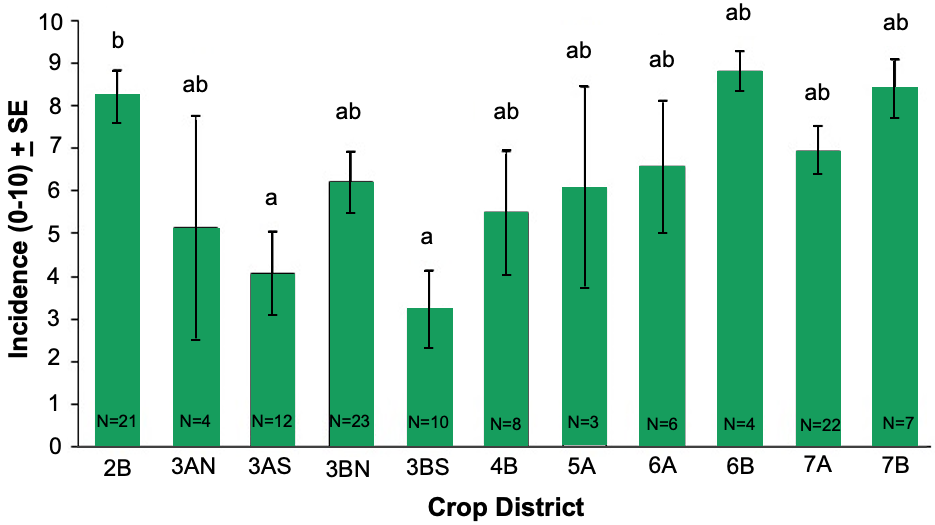
2020 Strobilurin Insensitivity
C. lentis was isolated from lentil tissue with visible anthracnose symptoms collected as part of the 2020 and 2021 surveys. The pathogen DNA was extracted from diseased plant tissue and evaluated using a polymerase chain reaction (PCR)-based molecular assay to determine the presence of strobilurin sensitive (wild type) or strobilurin insensitive (mutant) isolates. The PCR results were validated via an in vitro strobilurin fungicide (trifloxystrobin) tolerance plate assay.
From each of the fields surveyed in 2020, four (or fewer when availability was limited) samples were analyzed. Among the 333 samples assessed, 44% were insensitive to Group 11 fungicides, 34.5% were mixed collections of sensitive and insensitive isolates, 17% samples were sensitive and 4.5% samples could not be typed. In many fields, both sensitive and insensitive isolates were present. There was no difference in the proportion of isolates that were sensitive to strobilurins among crop districts nor did slope position affect sensitivity status.
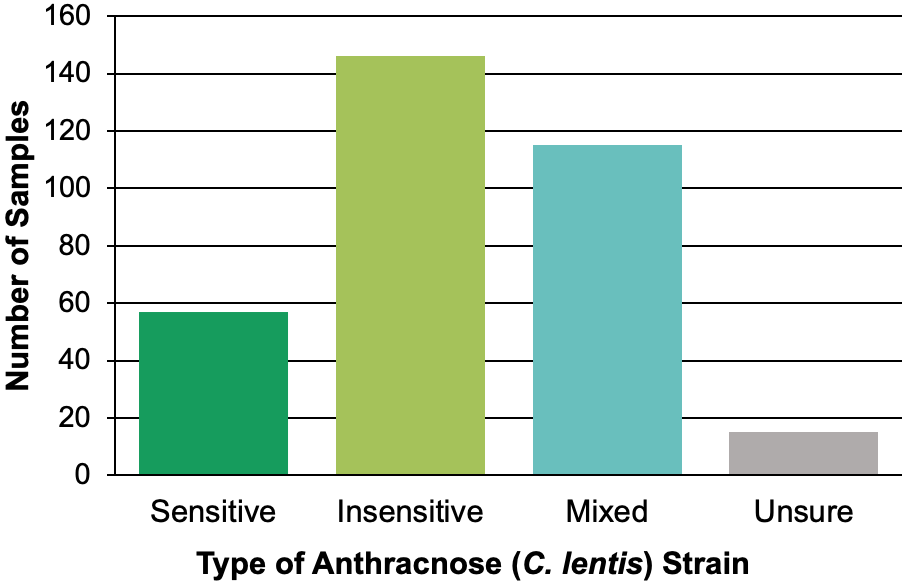
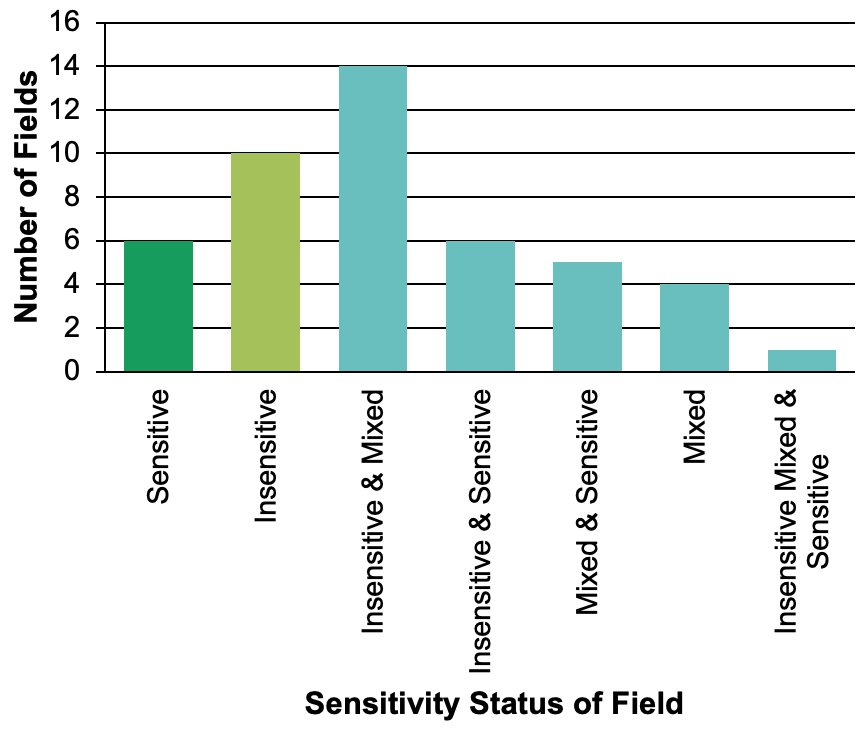
Of the fields surveyed in 2020, 46 of them had assessments of strobilurin sensitivity at four sites within the field. Of these fields, only 13% did not have any C. lentis with insensitivity to Group 11 fungicides detected via the molecular assay. The majority (87%) of the fields indicated some level of anthracnose insensitivity to strobilurin chemistry with completely insensitive isolates identified in 22% of the fields, and mixed populations detected in 65% of these fields.
When individual sites within fields were considered, the severity of anthracnose was higher at sites in which only strobilurin-sensitive or both sensitive and insensitive C. lentis isolates were detected compared to sites where only insensitive isolates were found. Although further investigation is needed, these initial results suggest that insensitive isolates may be less aggressive compared to sensitive isolates or that the mutation leading to the insensitivity is accompanied by a fitness penalty. A separate greenhouse study that examined fungicide product efficacy on anthracnose in lentil also found that certain fungicide treatments were worse at controlling Group 11-sensitive anthracnose.
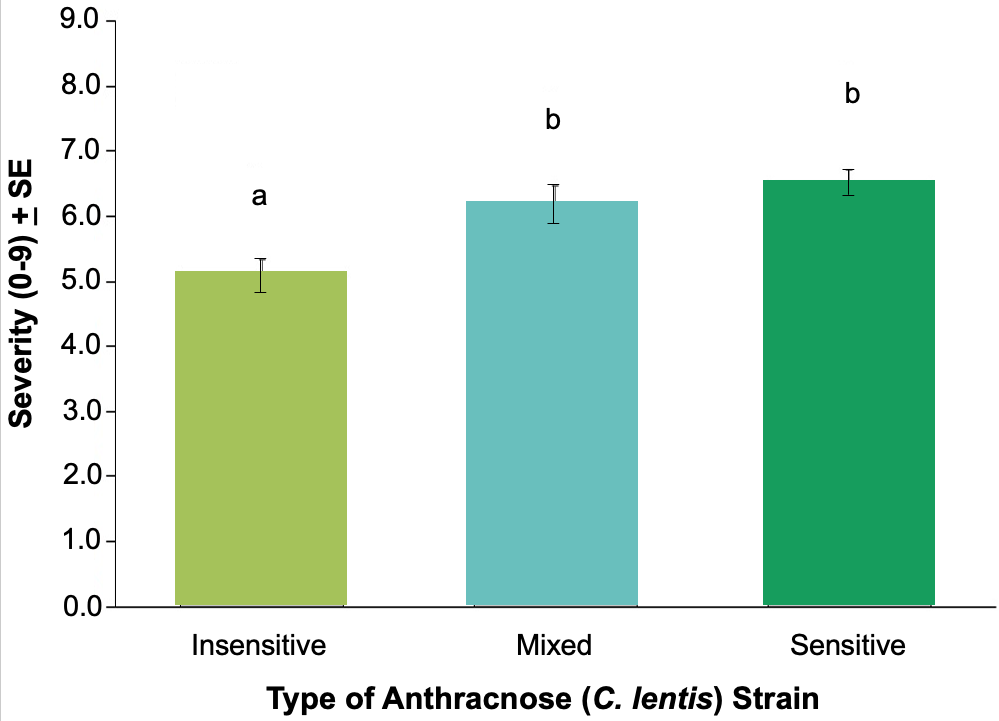
2020 Fungicide Applications
The total number of fungicide applications did not impact anthracnose disease incidence or severity in the 2020 survey. A single pass of fungicide was the most common application practice among fields in which fungicide application information was provided with 47 fields reported to have received one application, 12 fields received two applications, and only five fields that did not receive any fungicide application at all.
Fungicide application data collected during the 2020 survey reinforce the high use pattern of strobilurin-based fungicide products with 95% of the total product applications reported during 2020 survey containing at least one Group 11 active ingredients. These products included 26 applications of Delaro (Groups 3 and 11) with remainder of products consisting of combinations of Group 7 and Group 11 actives including Elatus (26 fields), Dyax (21 fields), and Priaxor (4 fields). The only stand-alone Group 3 fungicide application reported was Proline (4 fields).
Dyax (Groups 7 and 11) was the only fungicide application that was associated with statistically significant higher incidence and severity of anthracnose. This trend is particularly noticeable in crop district 2B where the majority of the fields in the survey that reported applications of Dyax were located and where the overall incidence of anthracnose disease pressure was high than in several other districts. Limited sample size and the nature of this survey make it difficult to conclude if this relationship is causative as these trends may be at least partly attributed to this fungicide being applied in fields with higher disease pressure.
Despite the widespread insensitivity to Group 11 fungicides, neither the application of a Group 3 nor a Group 7 fungicide was associated with a statistically significant reduction in disease incidence or severity.
Ongoing & Upcoming Research Plans
Analysis of 2021 Samples
Analysis of samples is currently underway to evaluate distribution of strains sensitive and insensitive to Group 11 fungicide in lentil surveyed during the 2021 survey.
2022 Field Survey
The lentil anthracnose survey is proposed to continue for another season in 2022. The protocol is expected to remain similar to the 2021 survey with an emphasis on collecting more agronomic information than the season prior, especially regarding fungicide application. Lentil growers interested in participating in the 2022 lentil anthracnose survey can enroll in the provincial pest monitoring program via this online sign-up form. For more information on the survey please contact Dr. Michelle Hubbard.
Additional Analysis
Further areas of analysis include:
- Evaluations of the aggressiveness and fitness of Group 11 sensitive and insensitive C. lentis isolates. These investigations will be supported through the proposed 2022 field survey, in vitro plate assays and growth chamber experiments.
- Screening for anthracnose insensitivity to Group 7 and Group 3 fungicides. Given that these groups are also widely found in fungicide product options for anthracnose in lentil, it will be important to ascertain the potential population sensitivity of C. lentis to these fungicide groups.
Acknowledgements
SPG would like to thank the many individuals who have contributed their time and expertise to understanding strobilurin insensitive anthracnose in lentil during recent seasons. Special acknowledgment is extended to the many surveyors and agronomists who collected and processed samples and data during the 2021 season including: AAFC Swift Current, AgGrow Consulting, BASF, Bayer, G-Mac’s AgTeam, Nutrien, Richardson Pioneer, Saskatchewan Ministry of Agriculture, Saskatchewan Association of Rural Municipalities, Soils and Such, Sustainable Agronomics L.S Ltd., and Syngenta. Thank you to all the growers who supported the surveys by providing access to their fields and contributing field history information. Funding support for this research been provided by the Agriculture Development Fund (Saskatchewan Ministry of Agriculture) and SPG.
Contributors/Authors:
- Dr. Michelle Hubbard—Research Scientist (Pulse Pathology)
- AAFC Dr. Zakir Hossain—Research Biologist (Pulse Pathology), AAFC
- Dr. Bruce Gossen—Research Scientist (Pulse Pathology), AAFC
- Sarah Anderson—Agronomy Manager, SPG
